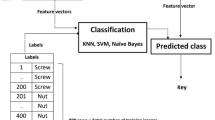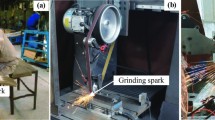Abstract
Difference between similar feature points is presented in the fine-grained classification, which depends on discriminative in extremely localized regions. Hence, the accurate localization of discriminative regions is the major challenge found in the fine-grained feature extraction and classification. The patch-based framework has been described to address this issue. The accurate patch localization is enhanced by the triplet of patches with the logical constraints, it minimnized the feature set. Therefore, the object bounding boxes are the only need for the proposed approach. This paper presents an effective fine-grained feature extraction and classification schemes for solid materials. The Fuzzy logic-Scale Invariant Feature Transform (FL-SIFT) is introduced for feature extraction. FL-SIFT based key points are taken for the classification is performed by hybrid Multilayer Perceptron with Faster Region Convolutional Neural Networks (MLP-Faster RCNN). A key advantage of fine-grained based MLP-Faster RCNN approach is, on average better in identification with FL-SIFT key points. The model is retrained to play out the recognition of four sorts of metal articles with the whole procedure taking 4 h time to clarify and prepare the new model per strong piece. The simulation is implemented on Python platform and the results are evaluated by several evaluation measures like specificity, accuracy, precision, f-measure, and recall. The performance outcomes are compared with the existing approaches and existing works. It shows that the proposed model achieved maximum outcomes than existing schemes in terms of accuracy 98.3%, Precision 96%, specificity 97.87% and it takes very low execution time 1.46 s.
















Similar content being viewed by others
References
Baddeley D, Bewersdorf J (2018) Biological insight from super-resolution microscopy: what we can learn from localization-based images. Annu Rev Biochem 87:965–989
Bindu H, Manjunathachary K (2019) Kernel-based scale-invariant feature transform and spherical SVM classifier for face recognition. J Eng Res 7(3):142–160
Chau NL, Tran NT, Dao TP (2020) A multi-response optimal design of bistable compliant mechanism using efficient approach of desirability, fuzzy logic, ANFIS and LAPO algorithm. Appl Soft Comput 94:106486
Chu J, Guo Z, Leng L (2018) Object detection based on multi-layer convolution feature fusion and online hard example mining. IEEE Access 6:19959–19967
Fang J, Zhou Y, Yu Y, Du S (2017) Fine-grained vehicle model recognition using a coarse-to-fine convolutional neural network architecture. IEEE Trans Intell Transp Syst 18(7):1782–1792
Ge C, Wang J, Wang J, Qi Q, Sun H, Liao J (2020) Towards automatic visual inspection: a weakly supervised learning method for industrial applicable object detection. Comput Ind 121:103232
Goswami A, McGrath J, Peters S, Rekatsinas T (2019) Fine-grained object detection over scientific document images with region Embeddings. arXiv preprint arXiv:1910.12462
Hassaballah M, Awad AI (2016) Detection and description of image features: an introduction. In: Image feature detectors and descriptors (pp. 1–8). Springer: Cham
Hassaballah M, Awad AI (eds) (2020) Deep learning in computer vision: principles and applications. CRC Press
Hsu HK, Yao CH, Tsai YH, Hung WC, Tseng HY, Singh M, Yang MH (2020) Progressive domain adaptation for object detection. In: Proceedings of the IEEE/CVF Winter Conference on Applications of Computer Vision, pp 749–757
Leng L, Yang Z, Kim C, Zhang Y (2020) A light-weight practical framework for feces detection and trait recognition. Sensors 20(9):2644
Li A, Chen J, Kang B, Zhuang W, Zhang X (2019) Adaptive multi-attention convolutional neural network for fine-grained image recognition. In: 2019 IEEE Globecom workshops (GC Wkshps) 1-5
Li J, Shi X, You ZH, Yi HC, Chen Z, Lin Q, Fang M (2020) Using weighted extreme learning machine combined with scale-invariant feature transform to predict protein-protein interactions from protein evolutionary information. IEEE/ACM Trans Comput Biol Bioinforma
Lin Z, Mu S, Huang F, Mateen KA, Wang M, Gao W, Jia J (2019) A unified matrix-based convolutional neural network for fine-grained image classification of wheat leaf diseases. IEEE Access 7:11570–11590
Lowe DG (2002) Object recognition from local scale-invariant features. In: The proceedings of the seventh IEEE international conference on computer vision, 1150
Lu L, Zhang J, Khan MK, Chen X, Alghathbar K (2010) Dynamic weighted discrimination power analysis: a novel approach for face and palmprint recognition in DCT domain. Int J Phys Sci 5(17):2543–2554
Moorthy U, Gandhi UD (2018) A survey of big data analytics using machine learning algorithms. In: HCI Challenges and Privacy Preservation in Big Data Security, IGI Global, 95–123
Pashaei A, Ghatee M, Sajedi H (2020) Convolution neural network joint with mixture of extreme learning machines for feature extraction and classification of accident images. J Real-Time Image Proc 17(4):1051–1066
Qiu H, Li H, Wu Q, Meng F, Shi H, Zhao T, Ngan KN (2020) Language-aware fine-grained object representation for referring expression comprehension. ACM International Conference on Multimedia, 4171-4180
Shariati M, Azar SM, Arjomand MA, Tehrani HS, Daei M, Safa M (2019) Comparison of dynamic behavior of shallow foundations based on pile and geosynthetic materials in fine-grained clayey soils. Geomech Eng 19(6):473–484
Sun X, Wu P, Hoi SC (2018) Face detection using deep learning: an improved faster RCNN approach. Neurocomputing 299:42–50
Tian G, Liu L, Ri J, Liu Y, Sun Y (2019) ObjectFusion: an object detection and segmentation framework with RGB-D SLAM and convolutional neural networks. Neurocomputing 345:3–14
Wang C, Wang Y, Han Y, Song L, Quan Z, Li J, Li X (2017) CNN-based object detection solutions for embedded heterogeneous multicore SoCs. Asia and South Pacific Design Automation Conference (ASP-DAC), pp 105–110
Wang L, Chen M, Wang L, Haoi Y, Hwang K (2017) Disease prediction by machine learning over big data from healthcare communities. IEEE Access
Wei J, He J, Zhou Y, Chen K, Tang Z, Xiong Z (2019) Enhanced object detection with deep convolutional neural networks for advanced driving assistance. IEEE Trans Intell Transp Syst 21(4):1572–1583
Yan J, Wang H, Yan M, Diao W, Sun X, Li H (2019) IoU-adaptive deformable R-CNN: make full use of IoU for multi-class object detection in remote sensing imagery. Remote Sens 11(3):286
Yang Z, Leng L, Kim BG (2019) StoolNet for color classification of stool medical images. Electronics 8(12):1464
Yao Y, Wang Y, Guo Y, Lin J, Qin H, Yan J (2020) Cross-dataset training for class increasing object detection. arXiv preprint arXiv:2001.04621
Yuan Y, Chu J, Leng L, Miao J, Kim BG (2020) A scale-adaptive object-tracking algorithm with occlusion detection. EURASIP J Image Video Process 2020(1):1–15
Zhang Y, Sohn K, Villegas R, Pan G, Lee H (2015) Improving object detection with deep convolutional networks via bayesian optimization and structured prediction. In: Proceedings of the IEEEConference on Computer Vision and Pattern Recognition, pp 249–258
Zhang L, Shen P, Zhu G, Wei W, Song H (2015) A fast robot identification and mapping algorithm based on kinect. Sensor 15(8):19937–19967. https://doi.org/10.3390/s150819937
Zhang J, Xing W, Xing M, Sun G (2018) Terahertz image detection with the improved faster region-based convolutional neural network. Sensors 18(7):2327
Zhang Y, Chu J, Leng L, Miao J (2020) Mask-refined R-CNN: a network for refining object details in instance segmentation. Sensors 20(4y):1010
Author information
Authors and Affiliations
Corresponding author
Additional information
Publisher’s note
Springer Nature remains neutral with regard to jurisdictional claims in published maps and institutional affiliations.
Rights and permissions
About this article
Cite this article
Dalai, R., Das, P. Effective fine-grained feature extraction and classification of solid materials using hybrid region convolutional neural networks. Multimed Tools Appl 80, 32171–32196 (2021). https://doi.org/10.1007/s11042-021-11189-0
Received:
Revised:
Accepted:
Published:
Issue Date:
DOI: https://doi.org/10.1007/s11042-021-11189-0




